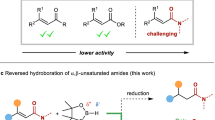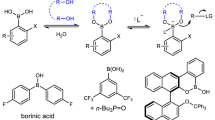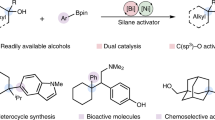Abstract
The protocol for the preparation of boron enolates and their subsequent reaction with aldehydes is described, providing convenient access to β-hydroxy ketones in good yields and with high stereoselectivities. The reaction consists of three steps: first, the ketone is rapidly converted to the corresponding boron enolate, by exposure to a chlorodialkylborane and tertiary amine base, which is then reacted in situ with the aldehyde. Finally, oxidative workup of the resultant boron aldolate provides aldol adduct. The reaction procedure requires approximately 28 h to complete over a 2-d period, consisting of 5 h to set up the reaction, whereupon the reaction mixture is left at −20 °C overnight (16 h), followed by 7 h for workup and purification.
This is a preview of subscription content, access via your institution
Access options
Subscribe to this journal
Receive 12 print issues and online access
$259.00 per year
only $21.58 per issue
Buy this article
- Purchase on Springer Link
- Instant access to full article PDF
Prices may be subject to local taxes which are calculated during checkout




Similar content being viewed by others
References
Kim, B.M., Williams, S.F. & Masamune, S. The aldol reaction: group III enolates. in Comprehensive Organic Synthesis (eds. Trost, B.M. & Fleming, I.) 301–320 (Pergamon Press, Oxford, 1991).
Cowden, C.J. & Paterson, I. Asymmetric aldol reactions using boron enolates. Org. React. 51, 1–200 (1997).
Paterson, I., Cowden, C.J. & Wallace, D.J. Stereoselective aldol reactions in the synthesis of polyketide natural products. in Modern Carbonyl Chemistry (ed. Otera, J.) 249–297 (Wiley-VCH, Weinheim, Germany, 2000).
Masamune, S., Choy, W., Petersen, J.S. & Sita, L.R. Double stereodifferentiation and a new strategy for stereocontrol in organic syntheses. Angew. Chem. Int. Ed. Engl. 24, 1–30 (1985).
Paton, R.S. & Goodman, J.M. Understanding the origins of remote asymmetric induction in the boron aldol reactions of β-alkoxy methyl ketones. Org. Lett. 8, 4299–4302 (2006).
Goodman, J.M. & Paton, R.S. Enantioselectivity in the boron aldol reactions of methyl ketones. Chem. Commun. 2124–2126 (2007).
Cergol, K.M., Turner, P. & Coster, M.J. The boron-mediated ketone–ketone aldol reaction. Tetrahedron Lett. 46, 1505–1509 (2005).
Cergol, K.M., Jensen, P., Turner, P. & Coster, M.J. Reversibility in the boron-mediated ketone–ketone aldol reaction. Chem. Commun. 1363–1365 (2007).
Brown, H.C., Dhar, R.K., Ganesan, K. & Singaram, B. Enolboration. 1. Dicyclohexylchloroborane/triethylamine as a convenient reagent for enolboration of ketones and other carbonyl derivatives. J. Org. Chem. 57, 499–504 (1992).
Evans, D.A., Nelson, J.V., Vogel, E. & Taber, T.R. Stereoselective aldol condensations via boron enolates. J. Am. Chem. Soc. 103, 3099–3111 (1981).
Paterson, I. & Goodman, J.M. Aldol reactions of methyl ketones using chiral boron reagents: a reversal in aldehyde enantioface selectivity. Tetrahedron Lett. 30, 997–1000 (1989).
Paterson, I. et al. Enantio- and diastereoselective aldol reactions of achiral ethyl and methyl ketones with aldehydes. The use of enol diisopinocampheylborinates. Tetrahedron 46, 4663–4684 (1990).
Paterson, I. et al. The stereocontrolled total synthesis of altohyrtin A/spongistatin 1: fragment couplings, completion of the synthesis, analogue generation and biological evaluation. Org. Biomol. Chem. 3, 2431–2440 (2005).
Paterson, I. et al. Stereocontrolled total synthesis of (+)-altohyrtin A/spongistatin 1. Angew. Chem. Int. Ed. 40, 4055–4060 (2001).
Paterson, I. & Coster, M.J. Total synthesis of altohyrtin A (spongistatin 1): an alternative synthesis of the CD-spiroacetal subunit. Tetrahedron Lett. 43, 3285–3289 (2002).
Paterson, I. & Coster, M.J. Total synthesis of spongistatin 1 (altohyrtin A): a tale of ten aldols from Strategies and Tactics in Organic Synthesis Vol. 4, Chapter 8, p. 211–245 (Elsevier, Oxford, UK, 2004).
Paterson, I., Coster, M.J., Chen, D.Y.K., Gibson, K.R. & Wallace, D.J. The stereocontrolled total synthesis of altohyrtin A/spongistatin 1: the CD-spiroacetal segment. Org. Biomol. Chem. 3, 2410–2419 (2005).
Paterson, I., Acena, J.L., Bach, J., Chen, D.Y.K. & Coster, M.J. Synthesis and biological evaluation of spongistatin/altohyrtin analogues: E-ring dehydration and C46 side-chain truncation. Chem. Commun. 462–463 (2003).
Paterson, I. et al. The stereocontrolled total synthesis of altohyrtin A/spongistatin 1: the southern hemisphere EF segment. Org. Biomol. Chem. 3, 2420–2430 (2005).
Paterson, I. et al. The stereocontrolled total synthesis of altohyrtin A/spongistatin 1: the AB-spiroacetal segment. Org. Biomol. Chem. 3, 2399–2409 (2005).
Author information
Authors and Affiliations
Corresponding author
Rights and permissions
About this article
Cite this article
Cergol, K., Coster, M. Asymmetric aldol reaction using boron enolates. Nat Protoc 2, 2568–2573 (2007). https://doi.org/10.1038/nprot.2007.372
Published:
Issue Date:
DOI: https://doi.org/10.1038/nprot.2007.372
Comments
By submitting a comment you agree to abide by our Terms and Community Guidelines. If you find something abusive or that does not comply with our terms or guidelines please flag it as inappropriate.



